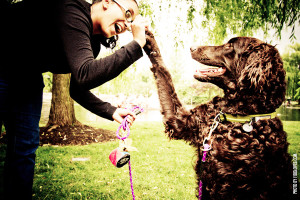If you aren’t getting a quick response, you know it’s time to work on training again. After all, training isn’t something you ever really finish…it’s a constant part of your relationship with your dog. But it can be overwhelming, and frustrating, for both you and your dog when the training breaks down. So keep it simple with these four tips.
Tip #1: Keep it fun
Why is fun so important? For starters, the quality of time you have to spend with your dog matters. Our time with them is always shorter than we want! Making it fun simply means you’ll both enjoy your short time together more.
There are also a couple of really practical reasons too. The more fun it is, the more focused your dog will be on the exercise. Successful training requires your dog’s attention. Keep in mind that you are in constant competition for it (think of all the smells and sounds and visual cues they are wired to pick up on). If you and whatever you are doing together are the most fun thing in the dog’s world at the moment, you’ve got a big advantage, and are more likely to to win that competition.
And finally when your pup is having fun, he or she is more relaxed, and when relaxed it is easier to imprint an experience. It’s like writing directly to the hard drive. If there’s too much pressure, you and your dog are likely to be more tense and reactive. Lessons have a harder time getting through and recalled later when under pressure.
Tip#2: Don’t Cue
If you’re not getting the desired response on the first try from your dog, it might be time to go back a few training steps. Take a few walks and without any commands. Bring a pocketful of treats with you. Your dog is bound to do something rewardable at some point, even accidentally, and when she does, give a treat and and a pat, and name the behavior (“good sit” for instance). Just a small treat is all it takes to signal that whatever he or she just did was good, and she will want to do it again. A good behavior, whether you ask for it or not, is still a great opportunity for training…just reinforce it with a treat. A couple of walks and you will have his or her attention back…and then you can start giving cues again.
Tip #3: Consistency
There’s a common refrain in dog training that it is more about training the people than the dogs. Are all the humans in your dog’s world on the same page? Come up with a few rules and commands that everyone can follow consistently, or you risk confusing the dog…which not only gives you unpredictable behavior but it is stressful on the dog.
Tip #4: Reward More
Trainers use a term called ‘rate of reinforcement’. It refers to how often good behavior is rewarded, and it’s important because it has a big impact on how a dog behaves. According to Karen Pryor Clicker Trainer Ken Ramirez, when training breaks down he looks at the reinforcement rate…if good behavior isn’t being rewarded consistently or frequently enough, then the dog might be confused or distracted. If you’re worried about your dog gaining too much weight, then do what professionals do: feed all or part of a meal throughout the day as rewards. If you are worried about making it all about food, once you’ve got the training back on track, substitute other rewards as part of the routine, but be careful that whatever you are using as a reward is something your dog really values. Food is typically a high value currency in the dog world, and it’s a great advantage in training to be able to dispense something of value.

